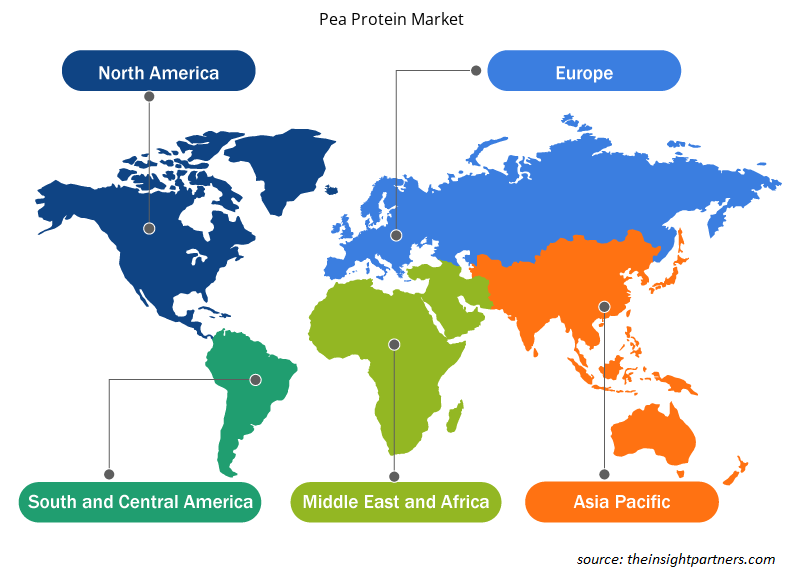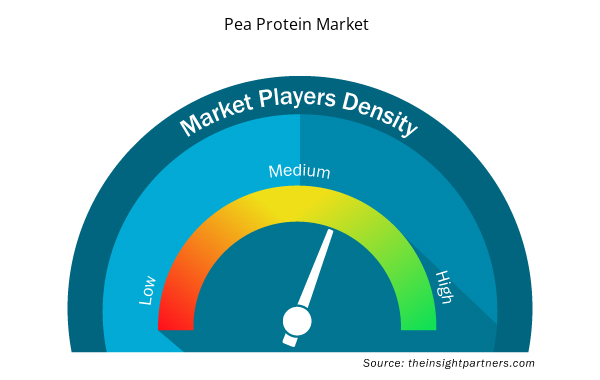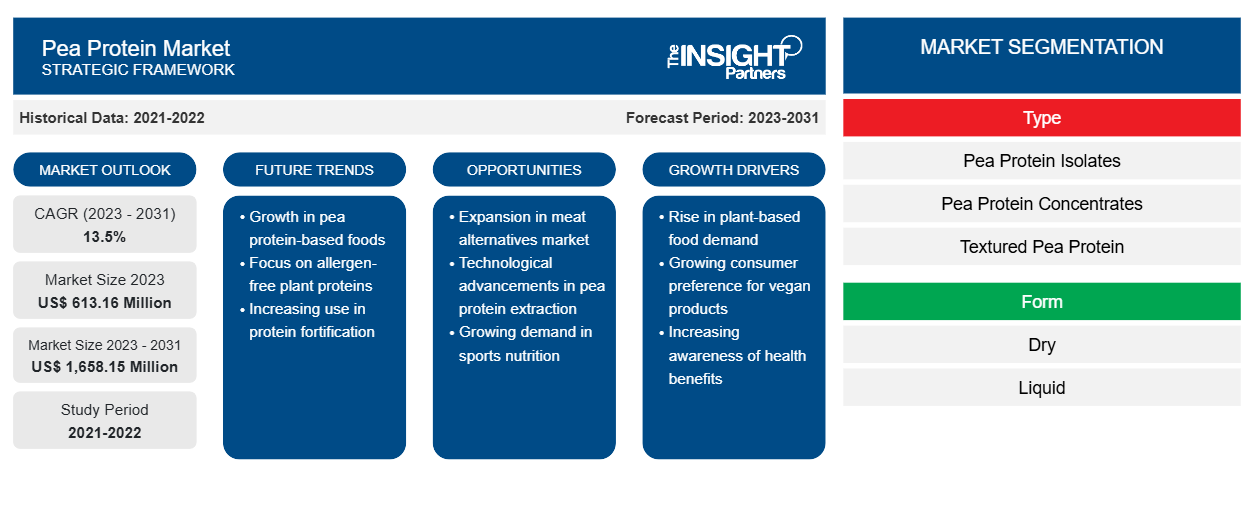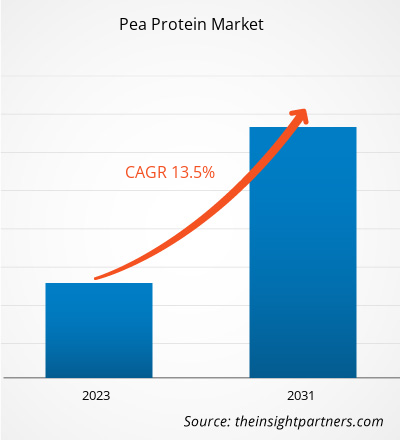Der Markt für Erbsenprotein wird voraussichtlich von 613,16 Millionen US-Dollar im Jahr 2023 auf 1.658,15 Millionen US-Dollar im Jahr 2031 anwachsen. Der Markt wird voraussichtlich zwischen 2023 und 2031 eine durchschnittliche jährliche Wachstumsrate (CAGR) von 13,5 % verzeichnen. Die glänzenden Verkaufszahlen von Erbsenprotein als Proteinquelle in Tiernahrung und Tierfutter werden wahrscheinlich weiterhin die wichtigsten Trends auf dem Markt für Erbsenprotein bleiben.
Erbsenprotein-Marktanalyse
Der Markt für Erbsenprotein wächst aufgrund von Faktoren wie einem gesteigerten Gesundheitsbewusstsein, zahlreichen gesundheitlichen Vorteilen und einer erhöhten Nachfrage nach Alternativen zu Fleischproteinen mit hoher Geschwindigkeit. Darüber hinaus haben Faktoren wie der Trend, Erbsenprotein in verschiedenen Produkten zu verwenden, das stetige Wachstum in der Lebensmittel- und Getränkeindustrie, die gestiegene Nachfrage nach Lebensmitteln auf Bio-Basis und Innovationen bei proteinbasierten Produkten das globale Wachstum des Erbsenproteinmarktes unterstützt. Die wachsende Zahl von Verbrauchern, die nach einfacheren Etiketten, großartigem Geschmack und alternativen Proteinquellen suchen, um personalisierte Ernährungsentscheidungen zu treffen, könnte wiederum das Wachstum des Erbsenproteinmarktes beschleunigen. Die Verfügbarkeit von Ersatzproteinen und das geringe Bewusstsein der Verbraucher für Produkte auf Erbsenproteinbasis könnten das Wachstum des Marktes im Prognosezeitraum jedoch einschränken.
Erbsenprotein-Marktübersicht
Erbsenprotein wird aus grünen und gelben Spalterbsen gewonnen und wird hauptsächlich zur Herstellung von Proteinpulver verwendet. Es dient oft als Grundlage für abgepackte Lebensmittel wie vegetarische Burger und vegane Mayonnaise und ersetzt sogar Milchprodukte in einigen Eiscremes und Milch. Erbsenprotein ist eine ausgezeichnete Eisenquelle. Es wird Lebensmitteln wie Smoothies und Shakes zugesetzt, um den Proteingehalt zu erhöhen, und passt auch gut zu fast jeder Diät, da es von Natur aus vegan und hypoallergen ist. Erbsenprotein enthält neun essentielle Aminosäuren, die der menschliche Körper nicht selbst herstellen kann.
Passen Sie diesen Bericht Ihren Anforderungen an
Sie erhalten kostenlos individuelle Anpassungen an jedem Bericht, einschließlich Teilen dieses Berichts oder einer Analyse auf Länderebene, eines Excel-Datenpakets sowie tolle Angebote und Rabatte für Start-ups und Universitäten.
- Holen Sie sich die wichtigsten Markttrends aus diesem Bericht.Dieses KOSTENLOSE Beispiel umfasst eine Datenanalyse von Markttrends bis hin zu Schätzungen und Prognosen.
Treiber und Chancen auf dem Erbsenproteinmarkt
Steigende Nachfrage nach Nahrungsergänzungsmitteln begünstigt den Markt
Erbsenprotein wird in Nutraceutika wie Nahrungsergänzungsmitteln und Gesundheitsergänzungsmitteln sowie für die Verdauungsgesundheit verwendet. Nahrungsergänzungsmittel werden oral entweder als Tablette, Kapsel, Pille oder Flüssigkeit eingenommen. Nahrungsergänzungsmittel sind Lebensmittel, die Mineralien, Vitamine, Kräuter oder andere pflanzliche Stoffe oder Aminosäuren enthalten. Erbsenproteine werden in Nahrungsergänzungsmitteln verwendet, damit sie dem Verbraucher eine externe Quelle für Vitamine, Mineralien , Ballaststoffe und andere wichtige Inhaltsstoffe bieten können. Die wachsende Nachfrage der Verbraucher nach diesen Nahrungsergänzungsmitteln hat das Wachstum des Marktes vorangetrieben.nutraceuticals such as dietary and health supplements, and for digestive health. A dietary supplement is consumed orally either as a tablet, capsule, pill, or a liquid. Dietary supplements are food products that contain mineral, vitamin, herb or other botanicals, or amino acids. Pea proteins are induced in dietary supplements so that they can provide an external source of vitamins,
Steigende Nachfrage nach Sportnahrung auf Erbsenproteinbasis und anderen Wellnessprodukten
Die verschiedenen funktionellen Eigenschaften von Erbsenprotein wie Emulgierung, Texturverbesserung und Schaumbildung haben sein Marktpotenzial erweitert. Wichtige Marktteilnehmer ergreifen Initiativen, um Produkte mit Erbsenprotein zu entwickeln, um die Nachfrage der Verbraucher zu befriedigen.
Segmentierungsanalyse des Erbsenprotein-Marktberichts
Wichtige Segmente, die zur Ableitung der Erbsenprotein-Marktanalyse beigetragen haben, sind Typ, Form und Anwendung.
- Basierend auf dem Typ ist der Erbsenproteinmarkt in Erbsenproteinisolate, Erbsenproteinkonzentrate und texturiertes Erbsenprotein segmentiert.
- Der Markt ist nach Form in trocken und flüssig unterteilt.
- Anwendungsbezogen ist der Markt segmentiert in Nahrungsergänzungsmittel, Back- und Süßwaren, Fleischalternativen, Getränke und Sonstiges.
Erbsenprotein-Marktanteilsanalyse nach Geografie
Der geografische Umfang des Erbsenproteinmarktberichts ist hauptsächlich in fünf Regionen unterteilt: Nordamerika, Asien-Pazifik, Europa, Naher Osten und Afrika sowie Südamerika/Süd- und Mittelamerika.
Nordamerika dominiert den Markt für Erbsenprotein. Das wachsende Interesse der Verbraucher an fleischlosen Alternativen als Folge der zunehmenden Sorge um einen gesunden Lebensstil hat es den Herstellern in Nordamerika ermöglicht, hochwertige pflanzliche Zutaten zu verwenden . Eine Zunahme von Umweltbedenken und ein gesteigertes Bewusstsein für Tierschutz haben den Fokus auf alternative Proteine aus pflanzlichen Proteinen verlagert. Der asiatisch-pazifische Raum wird in den kommenden Jahren voraussichtlich die höchste durchschnittliche jährliche Wachstumsrate aufweisen.
Regionale Einblicke in den Erbsenproteinmarkt
Die regionalen Trends und Faktoren, die den Erbsenproteinmarkt während des Prognosezeitraums beeinflussen, wurden von den Analysten von Insight Partners ausführlich erläutert. In diesem Abschnitt werden auch die Marktsegmente und die Geografie des Erbsenproteinmarkts in Nordamerika, Europa, im asiatisch-pazifischen Raum, im Nahen Osten und Afrika sowie in Süd- und Mittelamerika erörtert.

- Erhalten Sie regionalspezifische Daten zum Erbsenproteinmarkt
Umfang des Erbsenprotein-Marktberichts
| Berichtsattribut | Details |
|---|---|
| Marktgröße im Jahr 2023 | 613,16 Millionen US-Dollar |
| Marktgröße bis 2031 | 1.658,15 Millionen US-Dollar |
| Globale CAGR (2023 - 2031) | 13,5 % |
| Historische Daten | 2021-2022 |
| Prognosezeitraum | 2023–2031 |
| Abgedeckte Segmente | Nach Typ
|
| Abgedeckte Regionen und Länder | Nordamerika
|
| Marktführer und wichtige Unternehmensprofile |
|
Marktteilnehmerdichte: Der Einfluss auf die Geschäftsdynamik
Der Markt für Erbsenprotein wächst rasant, angetrieben durch die steigende Nachfrage der Endverbraucher aufgrund von Faktoren wie sich entwickelnden Verbraucherpräferenzen, technologischen Fortschritten und einem größeren Bewusstsein für die Vorteile des Produkts. Mit der steigenden Nachfrage erweitern Unternehmen ihr Angebot, entwickeln Innovationen, um die Bedürfnisse der Verbraucher zu erfüllen, und nutzen neue Trends, was das Marktwachstum weiter ankurbelt.
Die Marktteilnehmerdichte bezieht sich auf die Verteilung der Firmen oder Unternehmen, die in einem bestimmten Markt oder einer bestimmten Branche tätig sind. Sie gibt an, wie viele Wettbewerber (Marktteilnehmer) in einem bestimmten Marktraum im Verhältnis zu seiner Größe oder seinem gesamten Marktwert präsent sind.
Die wichtigsten auf dem Erbsenproteinmarkt tätigen Unternehmen sind:
- A&B Ingredients und Axiom Foods, Inc.
- Burcon Nutrascience Corporation
- Cosucra Groupe Warcoing SA
- Gemef Industries
- Glanbia Ernährung
- Puris, Roquette Frères
Haftungsausschluss : Die oben aufgeführten Unternehmen sind nicht in einer bestimmten Reihenfolge aufgeführt.

- Überblick über die wichtigsten Akteure auf dem Erbsenproteinmarkt
Neuigkeiten und aktuelle Entwicklungen zum Erbsenproteinmarkt
Der Erbsenproteinmarkt wird durch die Erhebung qualitativer und quantitativer Daten nach Primär- und Sekundärforschung bewertet, die wichtige Unternehmensveröffentlichungen, Verbandsdaten und Datenbanken umfasst. Im Folgenden finden Sie eine Liste der Entwicklungen auf dem Markt für Sprach- und Sprechstörungen und Strategien:
- Im Januar 2023 freut sich Burcon NutraScience Corporation, ein weltweit führendes Technologieunternehmen in der Entwicklung pflanzlicher Proteine für Lebensmittel und Getränke, bekannt zu geben, dass es vom US-Patent- und Markenamt („USPTO“) eine Zulassungsmitteilung für eine Patentanmeldung erhalten hat, die die Eigenschaften von Burcons Erbsenprotein Peazazz® abdeckt, das nach Burcons einzigartigem Verfahren hergestellt wird. Eine Zulassungsmitteilung des USPTO ist eine schriftliche Benachrichtigung, dass eine Patentanmeldung die interne Prüfung durchlaufen hat, zur Erteilung ansteht und in naher Zukunft erteilt wird. (Quelle: Burcon NutraScience Corporation, Pressemitteilung/Unternehmenswebsite/Newsletter, 2023)
Bericht zum Erbsenprotein-Markt – Umfang und Ergebnisse
Der Bericht „Marktgröße und Prognose für Erbsenprotein (2021–2031)“ bietet eine detaillierte Analyse des Marktes, die die folgenden Bereiche abdeckt:
- Marktgröße und Prognose auf globaler, regionaler und Länderebene für alle wichtigen Marktsegmente, die im Rahmen des Projekts abgedeckt sind
- Marktdynamik wie Treiber, Beschränkungen und wichtige Chancen
- Wichtige Zukunftstrends
- Detaillierte PEST/Porters Five Forces- und SWOT-Analyse
- Globale und regionale Marktanalyse mit wichtigen Markttrends, wichtigen Akteuren, Vorschriften und aktuellen Marktentwicklungen
- Branchenlandschaft und Wettbewerbsanalyse, einschließlich Marktkonzentration, Heatmap-Analyse, prominenten Akteuren und aktuellen Entwicklungen
- Detaillierte Firmenprofile
- Historische Analyse (2 Jahre), Basisjahr, Prognose (7 Jahre) mit CAGR
- PEST- und SWOT-Analyse
- Marktgröße Wert/Volumen – Global, Regional, Land
- Branche und Wettbewerbsumfeld
- Excel-Datensatz


- Environmental Consulting Service Market
- Public Key Infrastructure Market
- Identity Verification Market
- Europe Tortilla Market
- Diaper Packaging Machine Market
- Railway Braking System Market
- Smart Parking Market
- Automotive Fabric Market
- Artificial Intelligence in Healthcare Diagnosis Market
- Surgical Gowns Market

Report Coverage
Revenue forecast, Company Analysis, Industry landscape, Growth factors, and Trends

Segment Covered
This text is related
to segments covered.

Regional Scope
North America, Europe, Asia Pacific, Middle East & Africa, South & Central America

Country Scope
This text is related
to country scope.
Trends and growth analysis reports related to Food and Beverages : READ MORE..
The Insight Partners performs research in 4 major stages: Data Collection & Secondary Research, Primary Research, Data Analysis and Data Triangulation & Final Review.
- Data Collection and Secondary Research:
As a market research and consulting firm operating from a decade, we have published and advised several client across the globe. First step for any study will start with an assessment of currently available data and insights from existing reports. Further, historical and current market information is collected from Investor Presentations, Annual Reports, SEC Filings, etc., and other information related to company’s performance and market positioning are gathered from Paid Databases (Factiva, Hoovers, and Reuters) and various other publications available in public domain.
Several associations trade associates, technical forums, institutes, societies and organization are accessed to gain technical as well as market related insights through their publications such as research papers, blogs and press releases related to the studies are referred to get cues about the market. Further, white papers, journals, magazines, and other news articles published in last 3 years are scrutinized and analyzed to understand the current market trends.
- Primary Research:
The primarily interview analysis comprise of data obtained from industry participants interview and answers to survey questions gathered by in-house primary team.
For primary research, interviews are conducted with industry experts/CEOs/Marketing Managers/VPs/Subject Matter Experts from both demand and supply side to get a 360-degree view of the market. The primary team conducts several interviews based on the complexity of the markets to understand the various market trends and dynamics which makes research more credible and precise.
A typical research interview fulfils the following functions:
- Provides first-hand information on the market size, market trends, growth trends, competitive landscape, and outlook
- Validates and strengthens in-house secondary research findings
- Develops the analysis team’s expertise and market understanding
Primary research involves email interactions and telephone interviews for each market, category, segment, and sub-segment across geographies. The participants who typically take part in such a process include, but are not limited to:
- Industry participants: VPs, business development managers, market intelligence managers and national sales managers
- Outside experts: Valuation experts, research analysts and key opinion leaders specializing in the electronics and semiconductor industry.
Below is the breakup of our primary respondents by company, designation, and region:

Once we receive the confirmation from primary research sources or primary respondents, we finalize the base year market estimation and forecast the data as per the macroeconomic and microeconomic factors assessed during data collection.
- Data Analysis:
Once data is validated through both secondary as well as primary respondents, we finalize the market estimations by hypothesis formulation and factor analysis at regional and country level.
- Macro-Economic Factor Analysis:
We analyse macroeconomic indicators such the gross domestic product (GDP), increase in the demand for goods and services across industries, technological advancement, regional economic growth, governmental policies, the influence of COVID-19, PEST analysis, and other aspects. This analysis aids in setting benchmarks for various nations/regions and approximating market splits. Additionally, the general trend of the aforementioned components aid in determining the market's development possibilities.
- Country Level Data:
Various factors that are especially aligned to the country are taken into account to determine the market size for a certain area and country, including the presence of vendors, such as headquarters and offices, the country's GDP, demand patterns, and industry growth. To comprehend the market dynamics for the nation, a number of growth variables, inhibitors, application areas, and current market trends are researched. The aforementioned elements aid in determining the country's overall market's growth potential.
- Company Profile:
The “Table of Contents” is formulated by listing and analyzing more than 25 - 30 companies operating in the market ecosystem across geographies. However, we profile only 10 companies as a standard practice in our syndicate reports. These 10 companies comprise leading, emerging, and regional players. Nonetheless, our analysis is not restricted to the 10 listed companies, we also analyze other companies present in the market to develop a holistic view and understand the prevailing trends. The “Company Profiles” section in the report covers key facts, business description, products & services, financial information, SWOT analysis, and key developments. The financial information presented is extracted from the annual reports and official documents of the publicly listed companies. Upon collecting the information for the sections of respective companies, we verify them via various primary sources and then compile the data in respective company profiles. The company level information helps us in deriving the base number as well as in forecasting the market size.
- Developing Base Number:
Aggregation of sales statistics (2020-2022) and macro-economic factor, and other secondary and primary research insights are utilized to arrive at base number and related market shares for 2022. The data gaps are identified in this step and relevant market data is analyzed, collected from paid primary interviews or databases. On finalizing the base year market size, forecasts are developed on the basis of macro-economic, industry and market growth factors and company level analysis.
- Data Triangulation and Final Review:
The market findings and base year market size calculations are validated from supply as well as demand side. Demand side validations are based on macro-economic factor analysis and benchmarks for respective regions and countries. In case of supply side validations, revenues of major companies are estimated (in case not available) based on industry benchmark, approximate number of employees, product portfolio, and primary interviews revenues are gathered. Further revenue from target product/service segment is assessed to avoid overshooting of market statistics. In case of heavy deviations between supply and demand side values, all thes steps are repeated to achieve synchronization.
We follow an iterative model, wherein we share our research findings with Subject Matter Experts (SME’s) and Key Opinion Leaders (KOLs) until consensus view of the market is not formulated – this model negates any drastic deviation in the opinions of experts. Only validated and universally acceptable research findings are quoted in our reports.
We have important check points that we use to validate our research findings – which we call – data triangulation, where we validate the information, we generate from secondary sources with primary interviews and then we re-validate with our internal data bases and Subject matter experts. This comprehensive model enables us to deliver high quality, reliable data in shortest possible time.


 Holen Sie sich ein kostenloses Muster für diesen Bericht
Holen Sie sich ein kostenloses Muster für diesen Bericht